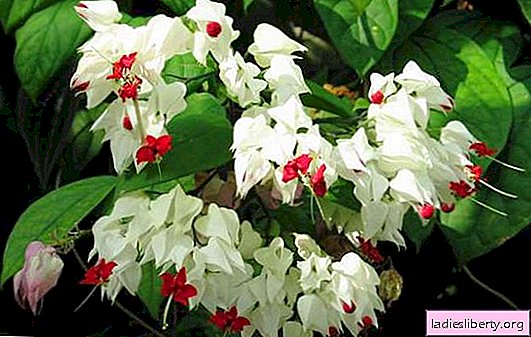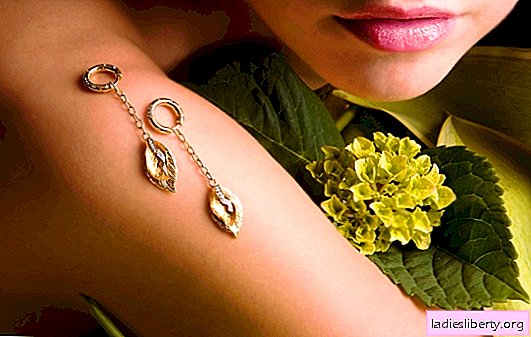
Clerodendrum is one of the most popular plants in indoor floriculture.
Translated from Greek, its name means "tree of fate."
Under natural conditions, representatives of the genus Clerodendrum grow in the tropical forests of the African continent, Asia and South America, there are more than 400 species. At home, such species are grown as:
• Thompson's Clodendrum - a fast-growing lignified liana. In winter, it can partially drop leaves. It is decorative due to its contrastingly colored flowers collected in clusters: bright red flowers peek out from snow-white bracts;
• the most beautiful - evergreen shrub reaching a height of up to 3 m. Flowering is plentiful from June to September. In the flowers, the corolla is dark red, the cup is purple;
• Filipino - clerodendrum, exuding a jasmine smell when flowering. Terry flowers, have a white-pink color and look like small roses, collected in inflorescences;
• fragrant - shrub with pubescent leaves. Abundantly and long blooming at home. The flowers have a strong citrus smell;
• Ugandan - lianoid shrub. Easily propagated by cuttings, grows quickly, unpretentious. The flowers have an unusual color: stamens, upper and side petals are blue, the lower ones are blue or purple.
Clerodendrum: landing
The soil for planting clerodendrum should be fertile and loose with a slightly acid reaction (pH = 5-6). For planting clerodendrum, both ready-made soils purchased in garden shops, and self-prepared are suitable. To do this, take in equal parts leaf and garden soil, peat, coarse sand. Before planting, the soil must be disinfected (treated with hot steam or calcined in the oven).
At the bottom of the pot, a drainage layer is made of large expanded clay, pieces of polystyrene foam, clay shards.
After planting, the plant is watered and kept on a windowsill with good illumination, but without direct sunlight.
Clerodendrum: growing
Clerodendrum can be grown both from seeds and vegetatively.
Seeds for planting can be used both bought in the store and collected directly from the plant. They ripen for about 3 months. The degree of maturity is determined as follows: unripened seeds are soft, the sepals around them are pink, and ripened are hard (sepals are dried).
Carrodendrum Seeds

Sowing is carried out in cups or plastic cups with a mixture of peat and sand (perlite) in March-April. Seeds are planted to a depth of about 1-2 cm. After this, the box is covered with film or glass or without shelter is placed in a greenhouse at a temperature of + 22-24 degrees. Periodically, the shelter is removed for ventilation, the accumulated condensate is removed. After emergence, the shelter is removed (if it was). Seedlings grow rapidly: at the age of one month they already have 4 full leaves. Replant their pots next spring.
Clerodendrum is also easy to grow from cuttings. They are harvested in the spring during pruning. Only ripened shoots are suitable for cuttings (green branches quickly rot). They are cut into pieces of 15-20 cm. It is easiest to root them in water with the addition of a root stimulant (Kornevin, Heteroauxin) and activated carbon tablets. After the appearance of the roots, the cuttings are planted in pots with prepared soil. The strongest seedlings bloom in the same year.
Rooted Clerodendrum Cuttings

You can also root cuttings in a greenhouse in a mixture of peat and sand at a temperature of + 22-24 degrees. The rate of rooting of cuttings depends on the type of clerodendrum (quickly rooted to. Ugandan and to. Thompson).
Clerodendrum: Care
Caring for clerodendum is quite simple, but has its own nuances.
As a native of the tropics, this plant needs increased humidity of air and soil. Therefore, it must often be sprayed and watered. Water for this is used at room temperature. In the spring-summer period, when the plant grows and blooms intensively, watered every 2-3 days. Excess water drained into the pan is immediately drained to prevent root decay. When watering, it is important to maintain balance and not to allow waterlogging or drying out of the earth in the pot. Otherwise, the plant may lose its leaves.
The most comfortable clerodendrum feels on the windowsills of the east or west. On the north window, due to lack of lighting, the plant may not bloom at all. If the flower is on the south side, then it must be shaded from direct sunlight.
The optimal temperature for the content of clerodendrum in spring and summer will be + 18-25 degrees. In winter, he has a period of rest and it’s enough + 13-15 degrees. If such a temperature regime is not observed, then flowering can not wait.
Another indispensable item in caring for clerodendrum is pruning. Since this plant is a fast-growing liana, in indoor conditions you can not do without pruning. Spend her in the spring. Shoots are shortened by 1/3. This procedure stimulates the growth of new shoots, on which inflorescences will form. In addition, pruning makes it possible to form a plant shape (curly, ampelous or bush). To give it a standardized appearance, they leave the central stem, the rest are cut out. At a height of 70-80 cm, the main shoot is shortened to stimulate tillering. From emerging lateral sprouts, a crown is formed by pinching. Root shoots must be cut in a timely manner.
After pruning, clerodendrum is fed with any complex fertilizer for flowering plants once every 2 weeks until the dormant period begins.
Problems When Growing Clodendrum
At home, clerodendrum is attacked by pests such as spider mites, whiteflies, scale insects, and aphids. To destroy them, insecticides (Aktara, Biotlin, Fitoverm, Confidor Extra) and acaricides (Actellik, Sunmayt, Fufanon) are used.
With excessive watering, clerodendrum can be affected by root rot. In this case, you need to pull the plant out of the pot, examine the root system: the affected areas are removed, the remaining ones are treated with fungicides (Topsin, copper sulfate, Oksikhom, etc.). After this, the flower is transplanted into a new pot and calcined soil.
Often, if the rules of care are not followed, the clerodendrum ceases to bloom. This occurs for the following reasons:
• the temperature regime + 13-15 ° C is not maintained during the rest period in winter;
• lack of nutrients;
• excess nitrogen fertilizers (the plant “lives on”: the leaves grow large, become dark green);
• deficit of lighting during the period of active growth;
With inadequate watering, lighting, dry and cold air, buds and flowers fall off at the clerodendrum.
Yellowing and falling of the leaves of clerodendrum can be caused by the following factors:
• natural process before the dormant period;
• poor watering
• dry and warm indoor air.
Watering clerodendrum with hard chlorinated water causes plant chlorosis: young leaves turn yellow, and old ones become marble in color.

The manifestation of chlorosis on the leaves of clerodendrum (marble color): dark veins, light leaf blade
Yellow-brown spots on the leaves appear with burns of leaves by intense sunlight.
With insufficient lighting, the clerodendrum is greatly extended, the leaves are smaller.











